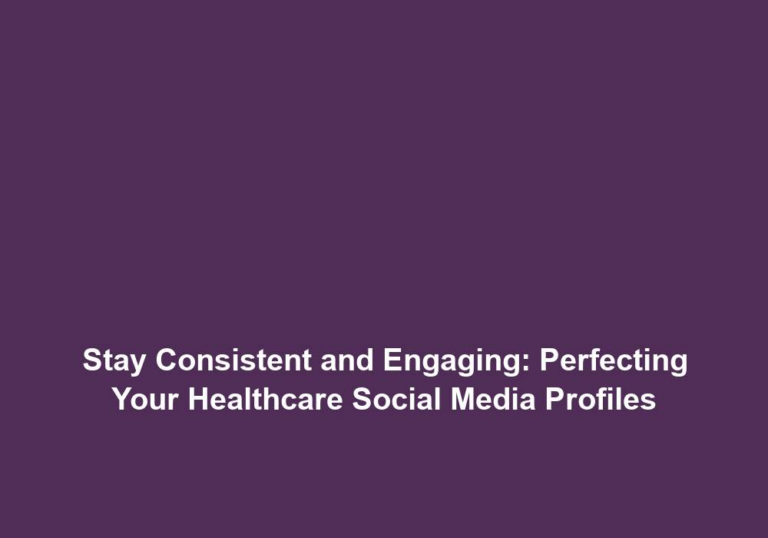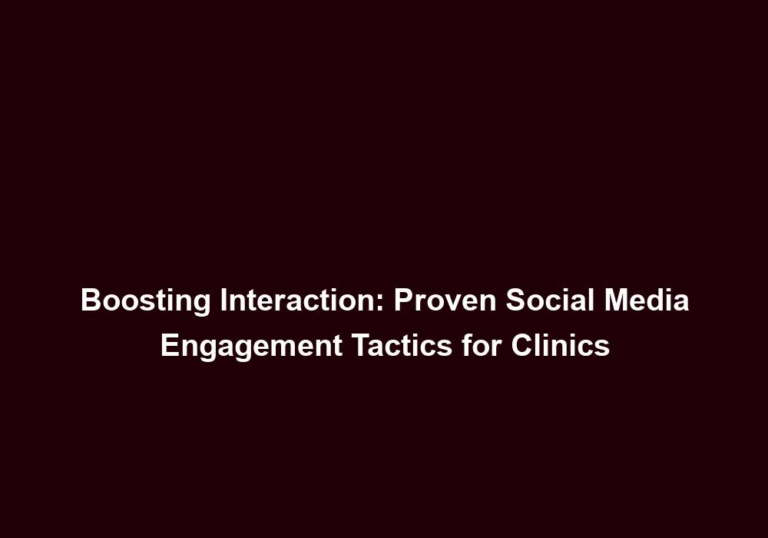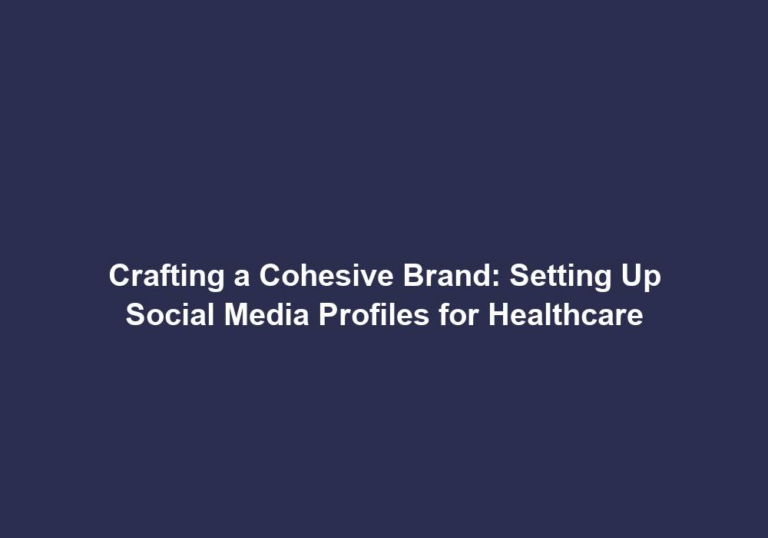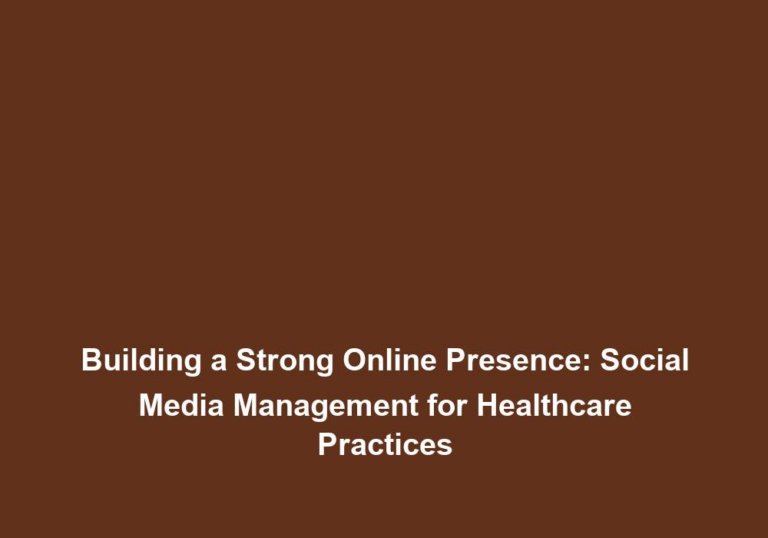Maximizing Online Reach: Effective Social Media Profile Management for Clinics
In today’s digital world, having a strong online presence is crucial for clinics to thrive and reach a wider audience. Social media platforms have become powerful tools for businesses to connect with potential patients, build brand awareness, and establish credibility. However, simply having a social media presence is not enough; effective profile management is key to maximizing your online reach. In this article, we will explore the essential strategies and best practices for managing social media profiles for clinics.
1. Define your clinic’s goals and target audience
Before diving into social media profile management, it is important to define your clinic’s goals and identify your target audience. Understanding what you want to achieve through your social media efforts will help shape your content strategy. Consider the following questions:
- What are your clinic’s objectives for using social media?
- Who is your ideal patient or target audience?
- What type of content will resonate with them?
By having a clear understanding of your goals and target audience, you can create content that is relevant, engaging, and effective.
Expanding on defining goals and target audience
When defining your clinic’s goals, it’s important to be specific and measurable. For example, your goals could be to increase website traffic, generate leads, or boost brand awareness. By having clear goals, you can tailor your social media content to align with these objectives.
In identifying your target audience, consider demographics such as age, gender, location, and interests. This will help you create content that appeals to their specific needs and preferences. Conducting market research and analyzing your existing patient base can provide valuable insights into your target audience.
To determine the type of content that will resonate with your audience, consider their pain points, interests, and preferences. Are they looking for educational content, tips and advice, or behind-the-scenes glimpses? Understanding their needs will help you create content that provides value and engages your audience.
2. Choose the right social media platforms
Not all social media platforms are created equal, and it is important to choose the ones that align with your clinic’s goals and target audience. Some popular platforms for clinics include:
With over 2.8 billion monthly active users, Facebook provides a vast audience for clinics to connect with. It allows you to share updates, create events, and engage with your audience through comments and messages.
Facebook is ideal for showcasing your clinic’s services, sharing patient testimonials, and promoting events or promotions. You can also utilize Facebook’s advertising features to reach a wider audience and target specific demographics.
Ideal for showcasing visual content, Instagram has over 1 billion monthly active users and is especially popular among younger demographics. It offers features like Stories, Reels, and IGTV, allowing clinics to share behind-the-scenes content and educational videos.
Instagram can be used to showcase before and after transformations, share patient success stories, and provide visual insights into your clinic’s facilities and staff. It’s also a great platform for collaborating with influencers and running contests or giveaways to engage your audience.
Twitter is a platform known for its real-time conversations. It is great for sharing quick updates, industry news, and engaging with influencers and thought leaders in the healthcare space.
On Twitter, you can share industry insights, participate in relevant hashtags, and join conversations with healthcare professionals and patients. It’s important to maintain an active presence on Twitter by regularly posting updates and responding to mentions and comments.
If your clinic targets professionals or B2B opportunities, LinkedIn can be a valuable platform. It allows you to share industry insights, network with other professionals, and establish your clinic as an authority in the field.
LinkedIn is a great platform for sharing educational content, such as blog articles or whitepapers, that are relevant to professionals in your industry. You can also showcase your clinic’s expertise by participating in industry groups and discussions.
Choose the platforms that best serve your clinic’s objectives and target audience, and focus on creating high-quality content specific to each platform.
3. Optimize your social media profiles
Once you have chosen the right platforms, it is essential to optimize your social media profiles to ensure they accurately represent your clinic and attract your target audience. Consider the following tips:
Clear and Consistent Branding
Use your clinic’s logo, colors, and brand elements consistently across all social media profiles to maintain a cohesive and recognizable brand identity. Ensure that your profile picture and cover image are high-quality and representative of your clinic.
Consistency in branding helps build trust and familiarity with your audience. It is important to create a visual identity that reflects your clinic’s values and resonates with your target audience.
Compelling Bio
Your bio should clearly describe what your clinic offers, its unique selling points, and a call-to-action to encourage users to take the desired action (such as booking an appointment or visiting your website). Use relevant keywords to improve discoverability.
In addition to describing your clinic’s services, consider highlighting any awards, certifications, or specializations that set your clinic apart from competitors. This will help establish your clinic’s credibility and expertise.
Contact Information
Make sure to include accurate contact information in your profile, such as phone number, email address, and website URL. This makes it easy for potential patients to get in touch with your clinic.
In addition to contact information, you can also include links to your other social media profiles or any online booking platforms you utilize. This streamlines the process for potential patients to connect with your clinic.
Content Guidelines
Establish guidelines for the type of content you will share and the tone of voice you will use. Consistency in content helps build trust and familiarity with your audience.
Consider the topics and themes that align with your clinic’s specialty and target audience. Will you focus on providing educational content, showcasing patient success stories, or sharing industry news? By setting content guidelines, you can ensure that your social media profiles consistently deliver valuable and engaging content.
4. Create valuable and engaging content
Once your profiles are optimized, it is time to create content that resonates with your target audience. Consider the following strategies:
Educational Content
Share informative and educational content related to your clinic’s specialty. This could include blog articles, videos, infographics, or thought leadership pieces that provide valuable insights to your audience.
Educational content establishes your clinic as a trusted source of information and positions your staff as knowledgeable experts in their field. Topics could include tips for maintaining good health, explanations of common procedures, or updates on the latest advancements in your specialty.
Patient Testimonials
Highlight the positive experiences of your patients through testimonials. This builds trust and credibility, attracting new patients to your clinic.
Testimonials can be shared as text posts, images, or videos. Consider reaching out to satisfied patients and asking them to share their stories. You can also offer incentives, such as discounts or freebies, to encourage patients to provide testimonials.
Behind-the-Scenes Content
Give your audience a glimpse into your clinic’s day-to-day operations, introducing your staff, showcasing your facilities, or sharing success stories. This humanizes your brand and creates a personal connection with your audience.
Behind-the-scenes content can include photos or videos of your staff in action, tours of your clinic, or interviews with team members. This type of content helps establish trust and transparency, giving your audience a sense of familiarity with your clinic.
Interactive Content
Encourage engagement by posting polls, quizzes, or asking questions to prompt user participation. This fosters a sense of community and encourages your audience to interact with your content.
Interactive content can be a fun and effective way to gather feedback from your audience, understand their preferences, and spark conversations. Consider asking your audience for their opinions on new treatments or procedures, or invite them to share their own experiences.
5. Consistency and monitoring
Consistency is key when managing social media profiles for clinics. Create a content calendar and stick to a regular posting schedule. Monitor your profiles regularly to respond to comments, messages, and reviews in a timely manner. Engage with your audience and address any concerns or inquiries promptly to maintain a positive online reputation.
Consistency in posting helps establish your clinic’s presence and keeps your audience engaged. Use social media management tools to schedule posts in advance and ensure a consistent flow of content.
Monitoring your profiles is essential to stay connected with your audience and address any feedback or inquiries. Regularly check your notifications, messages, and comments, and respond promptly and professionally. Addressing feedback and concerns in a timely manner shows that you value your patients and their experiences.
Conclusion
Effective social media profile management can significantly enhance your clinic’s online reach and visibility. By defining your goals, choosing the right platforms, optimizing your profiles, creating valuable content, and maintaining consistency, you can attract and engage with your target audience, ultimately driving more patients to your clinic. Stay proactive, monitor your profiles, and adapt your strategies based on audience feedback to ensure continued success in the ever-evolving digital landscape.







